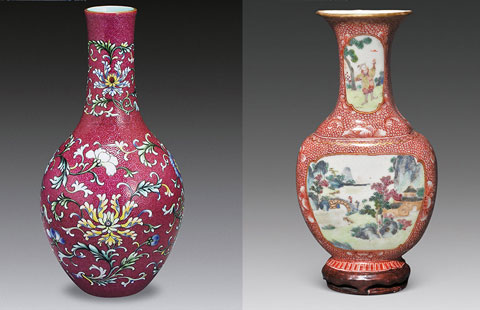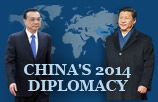BRICS bank vis-a-vis IMF
Updated: 2014-07-25 07:40
By Mark Williams(China Daily)
|
||||||||
Last week's agreement by the five BRICS member states to establish a development bank along with a currency reserve pool, they called the Contingency Reserve Arrangement, set off a storm of commentary suggesting that these new institutions would be rivals to the World Bank and the International Monetary Fund. But the key question of how they will operate remains unanswered, perhaps because the five countries haven't yet agreed on it among themselves. Perhaps, they will also be marginal players on the global stage in the foreseeable future.
The resources the BRICS bank (the official name is the New Development Bank), given its size, can mobilize will depend on several factors, including how cheaply it can borrow from international markets, how quickly it scales up its lending and capital base, and the average duration of loans.
Taking other development banks as a guide, we (at Capital Economics) estimate that loans could average $5-10 billion a year over the coming decade. That's less than one-third, taking the upper limit into consideration, of the $32 billion that the World Bank extended last year. More significantly perhaps, it is also a fraction of the amount lent abroad by China Development Bank, which now lends a similar amount to emerging economies each year as the World Bank. Viewed from this perspective, the World Bank already has a powerful rival from within the BRICS bloc.
Indeed, an unanswered question is whether the BRICS bank will substitute for or supplement the activities of the CDB. It could, for example, be used as a way to give multilateral cover to loans that would be contentious coming from one of China's State-owned banks. In that case, the creation of the BRICS bank may not lead to any substantial increase in lending to the emerging world.
Another unanswered question is for whom is the BRICS bank. The guiding sentiment behind its creation is a view that finance from the existing development lenders such as the World Bank comes with too many strings attached. If conditions are light and interest rates low, demand for BRICS bank loans will be strong (Argentina stands out as an obvious early candidate). But the issue of which projects to fund could prove contentious to the BRICS bank's members.
Last week's agreement stated that the BRICS bank would lend both within the BRICS countries and to other emerging economies. But its lending capacity will be limited, particularly in the early years, creating the potential for tension between those wanting to use the bank to support domestic development objectives, and those looking to support commercially viable projects wherever they might be. The fact that it took five years of talks to get the BRICS bank deal signed suggests that, behind the scenes, the BRICS member states have struggled to arrive at a consensus.
If the BRICS bank has been set up as a smaller rival to the World Bank, the CRA looks like an alternative to the IMF, albeit much smaller in size and ambition. The CRA is a system of currency swap agreements between the BRICS economies - in other words, agreements to lend to each other if some market disruption makes it difficult for them to access the needed foreign exchange.
The agreements will only exist on paper until the currency swaps are activated in the event of a crisis. There will be no pool of jointly managed reserves waiting for a rainy day. In this, the CRA resembles not so much the IMF as the Chiang Mai Initiative, which was established by Asian countries' governments after the Asian financial crisis and which remains to this day an agreement on paper only. While the IMF has been active in recent years in lending to struggling economies around the world, the swaps agreed under the Chiang Mai Initiative have never been used. This is one reason to be cautious about the impact the CRA will have.
Another issue is the BRICS bank's size. The agreed swaps add up on paper to only $100 billion, compared with the more than $1 trillion pledged or committed to the IMF. But the main reason to question the talk of the CRA challenging the IMF is that it will be limited to the five BRICS economies. For any other economies that run into trouble financing external obligations, the IMF is likely to remain the prime multilateral source of support.
The author is chief Asia economist at Capital Economics, a London-based independent macroeconomic research consultancy.

 Music at her fingers
Music at her fingers
 Across America Over the Week (Jan 16 - Jan 22)
Across America Over the Week (Jan 16 - Jan 22)
 Spend Chinese New Year in style
Spend Chinese New Year in style
 Ili river valley becomes a popular destination for swans
Ili river valley becomes a popular destination for swans
 Philip Ma: from scientist to businessman
Philip Ma: from scientist to businessman
 Birmingham's Spotlight on China dinner
Birmingham's Spotlight on China dinner
 How to distinguish doucai, wucai, Famille-rose and enamel porcelain
How to distinguish doucai, wucai, Famille-rose and enamel porcelain
 Xinjiang lake in bumper fishing season
Xinjiang lake in bumper fishing season
Most Viewed
Editor's Picks

|

|

|

|

|

|
Today's Top News
Houston's SW Chinatown
China to focus on reforms, opening of capital market
Slowdown brings new risks to banks
Trade group calls for BIT
Market status for China is 'political' issue
Birmingham's Spotlight on China dinner
Bank takes renminbi-clearing seriously
Traditional Garb
US Weekly

|

|







